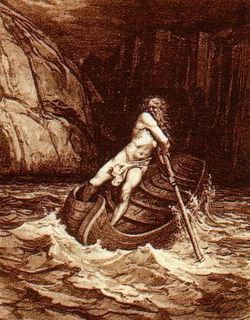A long journey among the flames of hell.
The Divina Commedia is one of the greatest poems of the Middle Ages. The work is divided into three parts (cantiche): Inferno, Purgatory and Paradise, each containing 33 Cantos, plus the introductory Canto I of Inferno. The part we have studied this year is the Inferno.
Dante conceives Hell as a great funnel-shaped cave lying below the northern hemisphere with its bottom point at the earth’s centre where Lucifer lives. Around this great circular depression runs a series of ledges, each of which Dante calls a Circle. Each circle is assigned to the punishment of one category of sin, which becomes worser as the abyss gets deeper. The circles are populated with monstruous mythological creatures which guard the place they are assigned to. Dante depicted this imaginary place according to the mentality of his time: a dark world with no stars, where there is only weeping, pain and cries: a gloomy, deep atmosphere at times violently swept by strong winds whose blows are as feroucious as the roar of a stormy sea or as the heavy cold rains which constantly shake the damned souls. Thus Dante describes the Gate of Hell, a blank place where everything is wrapped in heavy shadows.
Dante imagines to be the protagonist of an extraordinary journey that lasted about one week and which took him, during the Spring of 1300, through the three realms of the afterlife: Hell, Purgatory and Paradise. The journey is full of tremendous obstacles and the gloomy atmosphere of hell frightens the traveller. Yet, he is not alone, but is guided by Virgil, the Latin poet who lived in the 1st century B.C.
This journey should not be looked upon as a mere narrative description of the afterlife, but must be interpreted following its deep, allegorical meaning: Dante represents mankind who experiences a profound spiritual crises which one can overcome only if aided by human reason (represented by Virgil’s figure) and faith.
The guardians of Hell
Dante’s poem thrills the modern reader’s imagination by the use of various mythological figures, monsters which are to be found at the entrance of each circle. Among these:
Charon, the ferryman who carries the dead souls across the Acheron, the first of the rivers of Hell, over to punishment. He is not a wise man; he is old and has a thick beard as white as his hair; with eyes of flames he threatens and frightens the damned souls.
Minos is the dread monster, judge of the damned who horrendously growls like a dog while assigning to each soul its eternal torment. After hearing each admission of sin, he decides to which circle sinners must go. Then his tail twists around him forming as many circles as those the damned soul must descend.
Cerberus is the ravenous three-headed dog of Hell who barks against the sinners that lie in the slush. He has eyes of fire, a large belly and with his claws and teeth rips and tears the souls of the third circle: the Gluttons.a hoarders’ sins.
Each of these monsters tries to stop Dante from descending through the circles of Hell, but Virgil silences them and so the poets move on.
quando noi fermerem li nostri passi
su la trista riviera d’Acheronte".
Allor con li occhi vergognosi e bassi,
temendo no ‘l mio dir li fosse grave,
infino al fiume del parlar mi trassi.
Ed ecco verso noi venir per nave
Un vecchio, bianco per antico pelo,
gridando: "Guai a voi, anime prave!
Non isperate mai veder lo cielo:
i’vegno per menarvi a l’altra riva
ne le tenebre etterne, in caldo e’n gelo.
E tu che se’ costì, anima viva,
pàrtiti da cotesti che son morti".
Ma poi che vide ch’io non mi partiva,
disse: "Per altra via, per altriporti
verrai a piaggia, non qui, per passare:
più lieve legno convien che ti porti".
E ‘l duca lui: "Caron, non ti crucciare:
vuolsi così colà dove si puote
ciò che si vuole, e più non dimandare".
(Inferno, Canto II, Dante Alighieri, La Divina Commedia)
This text is a work of the Italian school of Liceo "Ugo Mursia"- Carini




















































































